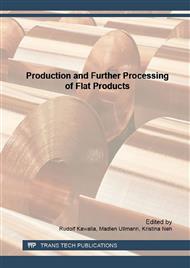p.87
p.93
p.99
p.106
p.112
p.118
p.124
p.133
p.140
Cyclic Tension Test of AZ31 Magnesium Alloy at Elevated Temperature Realized in a Miniaturized Uniaxial Tensile Test Setup
Abstract:
The use of new materials, e.g. aluminum and magnesium alloys, in the automotive and aviation sector is becoming increasingly important to reach the global aim of reduced emissions. Especially magnesium alloys with their low density offer great potential for lightweight design. However, magnesium alloys are almost exclusively formable at elevated temperatures. Therefore, material characterization methods need to be developed for determining the mechanical properties at elevated temperatures. In particular, cyclic tests at elevated temperatures are required to identify the isotropic-kinematic hardening behavior, which is important for numerically modeling the springback behavior. In this contribution, a characterization method for determining the cyclic behavior of the magnesium alloy AZ31B at an elevated temperature of 200 °C is presented. The setup consists of a miniaturized tensile specimen and stabilization plates to prevent buckling under compressive load. The temperature in the relevant area is introduced with the help of conductive heating. Moreover, the complex kinematic model according to Chaboche and Rousselier is identified, to map the transient hardening behavior of AZ31B after load reversal, which cannot be modeled with a single Bauschinger coefficient.
Info:
Periodical:
Pages:
112-117
Citation:
Online since:
May 2016
Authors:
Keywords:
Permissions:
Share:
Citation:


